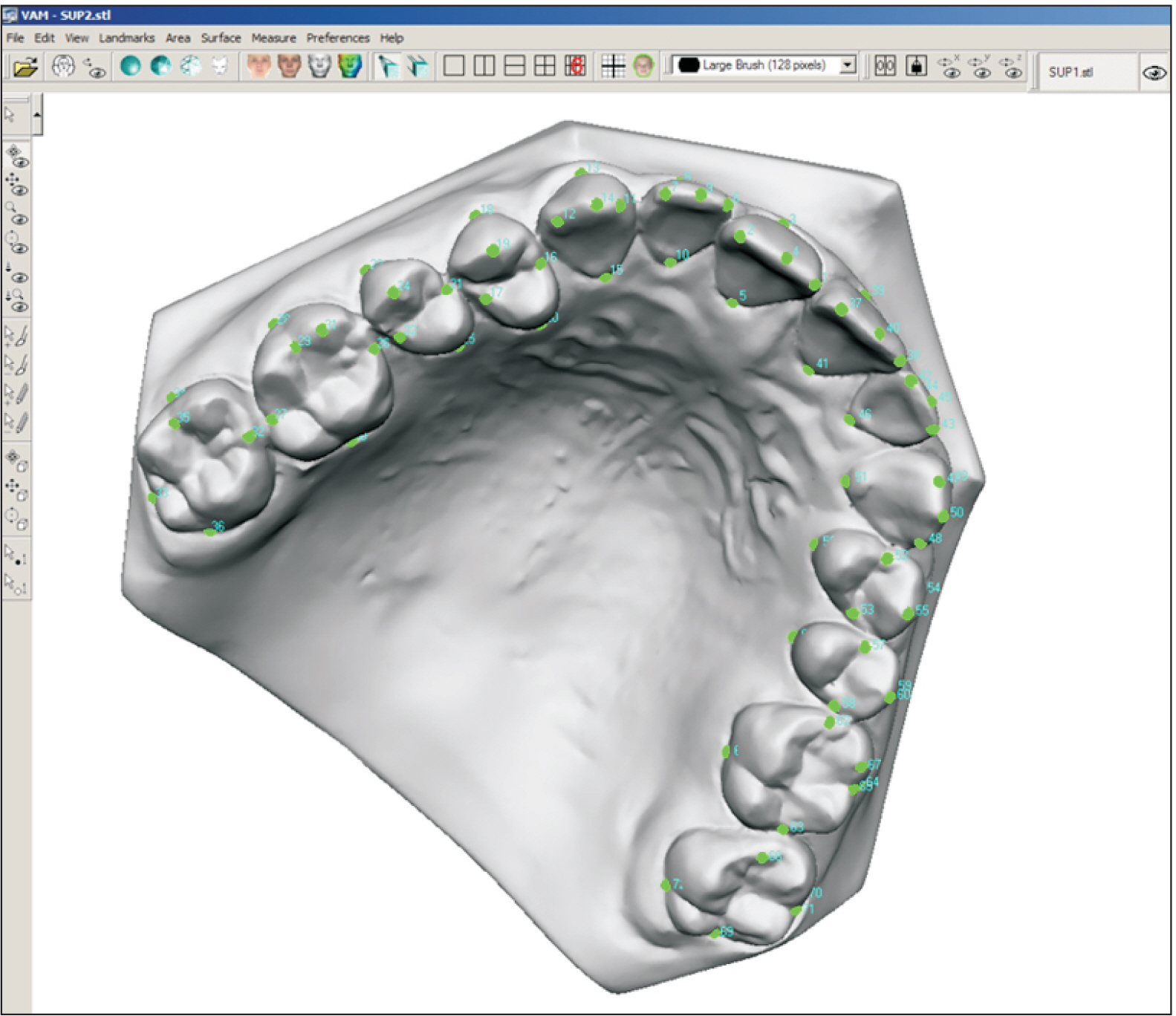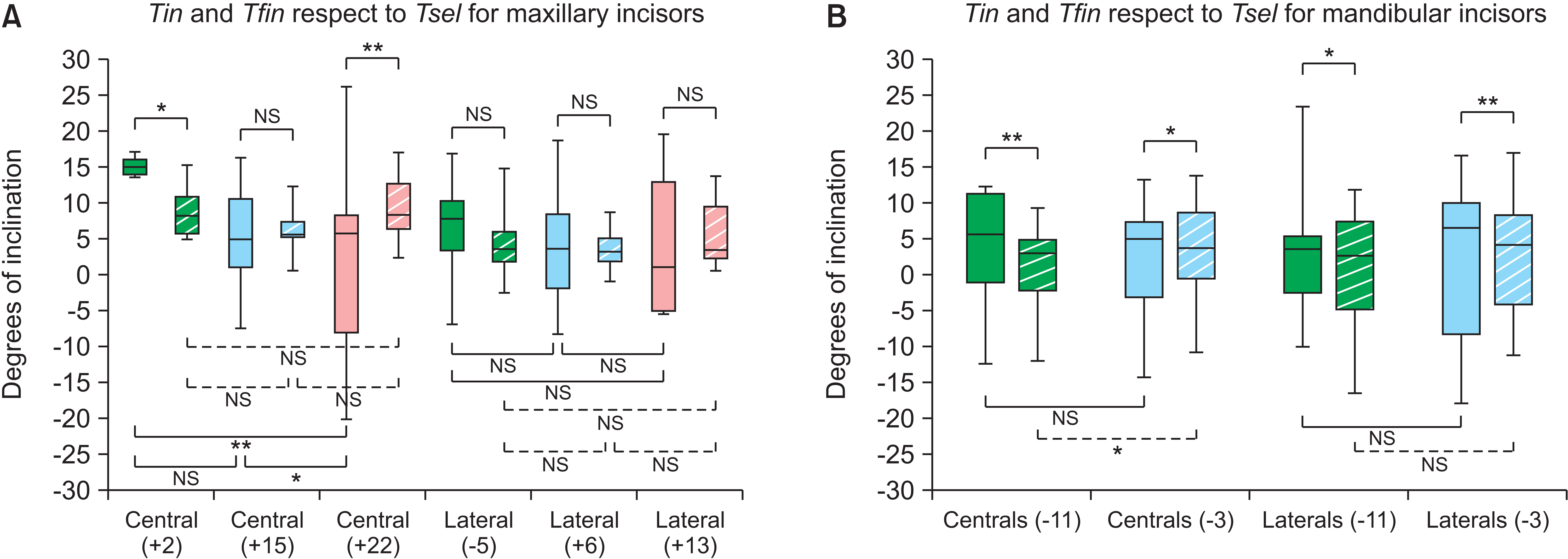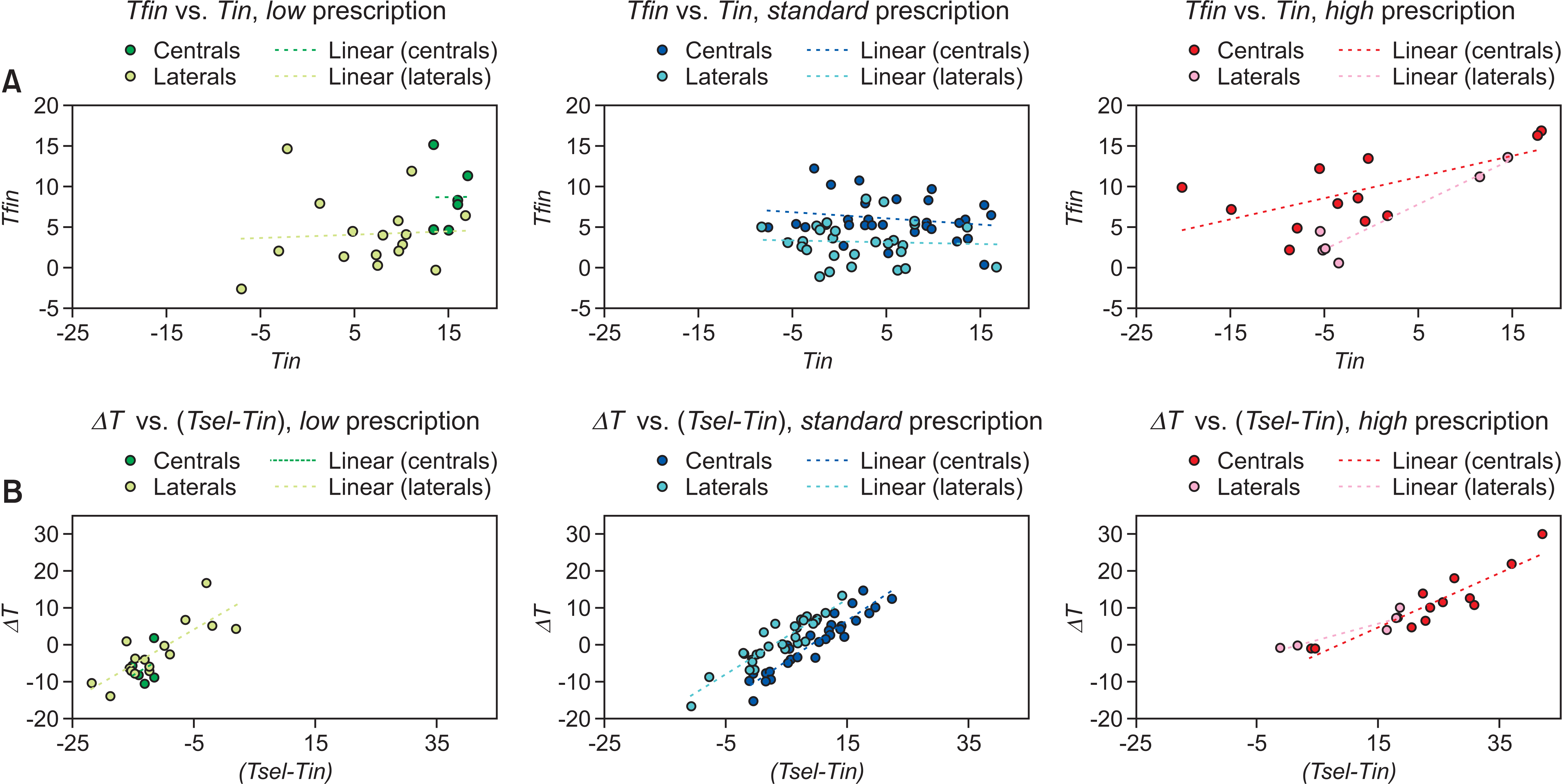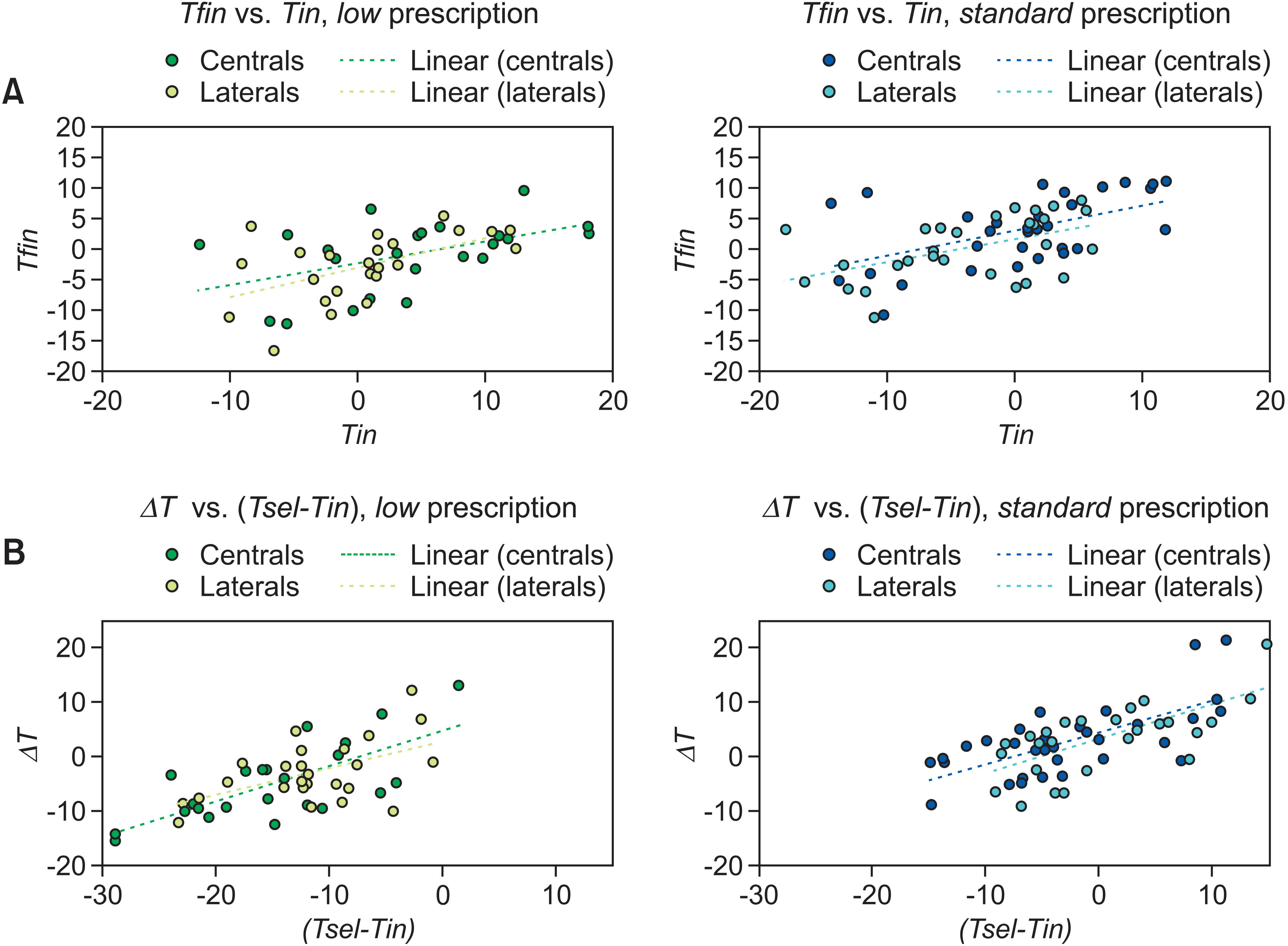Korean J Orthod.
2022 Nov;52(6):387-398. 10.4041/kjod22.009.
Clinical effects of different prescriptions on the inclination of maxillary and mandibular incisors by using passive self-ligating brackets
- Affiliations
-
- 1Division of Paediatric Dentistry and Orthodontics, Faculty of Dentistry, The University of Hong Kong, Hong Kong SAR
- 2Division of Orofacial Pain, College of Dentistry, University of Kentucky, Lexington, KY, USA
- 3Department of Orthodontics, University of Geneva, Geneva, Switzerland
- 4Orthodontics, Dental School, Department of Medical and Surgical Specialties, Radiological Sciences and Public Health, University of Brescia, Brescia, Italy
- KMID: 2536332
- DOI: http://doi.org/10.4041/kjod22.009
Abstract
Objective
Controlling the incisal inclination is fundamental in orthodontics. However, the relationship between the inclination prescription and its clinical outcome is not obvious, and the incisal inclination changes generated by different bracket prescriptions were investigated.
Methods
Twenty-eight nonextraction dental Class II patients (15 females, 13 males; mean age = 12.9) were retrospectively analyzed. Patients were treated using passive self-ligating fixed appliances with three inclination prescriptions for maxillary incisors (high, standard, low), and two for mandibular incisors (standard, low). Clinical outcomes were compared among different prescriptions, and regression analysis was used to explain the effects of bracket prescriptions and to understand the prescription selection criteria (α = 0.05).
Results
For maxillary central incisors, low and high prescriptions were related to linguoversion (p = 0.046) and labioversion (p = 0.005), respectively, while standard prescription maintained the initial dental inclination. Maxillary lateral incisors did not show significant changes. For mandibular incisors, low prescription led to linguoversion (p = 0.005 for central incisors, p = 0.010 for lateral incisors), while standard prescription led to labioversion (p = 0.045 for central incisors, p = 0.005 for lateral incisors). The factors affecting inclination changes were the imposed change and selected prescription, while prescription selection was influenced by the initial dental inclination and initial intercanine distance.
Conclusions
The direction of correction of incisal inclination can be controlled by choosing a certain prescription, but the final inclination may show limited consistency with it. The amount of imposed inclination change was the most relevant predictor of the clinical outcome.
Keyword
Figure
Reference
-
References
1. Kilpeläinen PV, Phillips C, Tulloch JF. 1993; Anterior tooth position and motivation for early treatment. Angle Orthod. 63:171–4. DOI: 10.1043/0003-3219(1993)063<0171:ATPAMF>2.0.CO;2. PMID: 8214784.2. Matarese G, Isola G, Ramaglia L, Dalessandri D, Lucchese A, Alibrandi A, et al. 2016; Periodontal biotype: characteristic, prevalence and dimensions related to dental malocclusion. Minerva Stomatol. 65:231–8. PMID: 27035270. PMID: https://www.scopus.com/inward/record.uri?partnerID=HzOxMe3b&scp=84977663922&origin=inward.3. Perillo L, Padricelli G, Isola G, Femiano F, Chiodini P, Matarese G. 2012; Class II malocclusion division 1: a new classification method by cephalometric analysis. Eur J Paediatr Dent. 13:192–6. PMID: 22971255.4. Perillo L, Isola G, Esercizio D, Iovane M, Triolo G, Matarese G. 2013; Differences in craniofacial characteristics in Southern Italian children from Naples: a retrospective study by cephalometric analysis. Eur J Paediatr Dent. 14:195–8. PMID: 24295003.5. Tweed CH. 1944-1945; Indications for the extraction of teeth in orthodontic procedure. Am J Orthod Oral Surg. 42:22–45. DOI: 10.1016/s0096-6347(44)90038-4. PMID: 21024940. PMID: https://www.scopus.com/inward/record.uri?partnerID=HzOxMe3b&scp=0006529844&origin=inward.6. Andrews LF. 1972; The six keys to normal occlusion. Am J Orthod. 62:296–309. DOI: 10.1016/S0002-9416(72)90268-0. PMID: 4505873. PMID: https://www.scopus.com/inward/record.uri?partnerID=HzOxMe3b&scp=0015400312&origin=inward.7. Andrews LF. 1976; The straight-wire appliance, origin, controversy, commentary. J Clin Orthod. 10:99–114. PMID: 1074876. PMID: https://www.scopus.com/inward/record.uri?partnerID=HzOxMe3b&scp=0016922634&origin=inward.8. Moesi B, Dyer F, Benson PE. 2013; Roth versus MBT: does bracket prescription have an effect on the subjective outcome of pre-adjusted edgewise treatment? Eur J Orthod. 35:236–43. DOI: 10.1093/ejo/cjr126. PMID: 22051535. PMID: https://www.scopus.com/inward/record.uri?partnerID=HzOxMe3b&scp=84875731957&origin=inward.9. Breckon J. 2009; The 20 principles of the Alexander discipline. Eur J Orthod. 31:213–8. DOI: 10.1093/ejo/cjn120.10. McLaughlin RP, Bennett JC, Trevisi HJ. 2021. Systemized orthodontic treatment mechanics. Mosby;St. Louis: DOI: 10.1093/ejo/cjn120.11. Ricketts RM. 1976; Bioprogressive therapy as an answer to orthodontic needs. Part II. Am J Orthod. 70:359–97. DOI: 10.1016/0002-9416(76)90111-1. PMID: 1067757. PMID: https://www.scopus.com/inward/record.uri?partnerID=HzOxMe3b&scp=0017142332&origin=inward.12. Damon DH. 1998; The Damon low-friction bracket: a biologically compatible straight-wire system. J Clin Orthod. 32:670–80. PMID: 10388398. PMID: https://www.scopus.com/inward/record.uri?partnerID=HzOxMe3b&scp=0032199846&origin=inward.13. Savoldi F, Bonetti S, Dalessandri D, Mandelli G, Paganelli C. 2015; Incisal apical root resorption evaluation after low-friction orthodontic treatment using two-dimensional radiographic imaging and trigonometric correction. J Clin Diagn Res. 9:ZC70–4. DOI: 10.7860/JCDR/2015/14140.6841. PMID: 26676099. PMCID: PMC4668528. PMID: 8afb1ab45384426eb7c8628ed13d84ae. PMID: https://www.scopus.com/inward/record.uri?partnerID=HzOxMe3b&scp=84946550000&origin=inward.14. Johnson E. 2013; Selecting custom torque prescriptions for the straight-wire appliance. Am J Orthod Dentofacial Orthop. 143(4 Suppl):S161–7. DOI: 10.1016/j.ajodo.2012.09.003. PMID: 23540633. PMID: https://www.scopus.com/inward/record.uri?partnerID=HzOxMe3b&scp=84875730946&origin=inward.15. Castro IO, Frazão Gribel B, Alencar AHG, Valladares-Neto J, Estrela C. 2018; Evaluation of crown inclination and angulation after orthodontic treatment using digital models: comparison to the prescription of the brackets used. J Orofac Orthop. 79:227–34. DOI: 10.1007/s00056-018-0136-2. PMID: 29644390. PMID: https://www.scopus.com/inward/record.uri?partnerID=HzOxMe3b&scp=85049735847&origin=inward.16. Arreghini A, Lombardo L, Mollica F, Siciliani G. 2014; Torque expression capacity of 0.018 and 0.022 bracket slots by changing archwire material and cross section. Prog Orthod. 15:53. DOI: 10.1186/s40510-014-0053-x. PMID: 25329505. PMCID: PMC4176837. PMID: https://www.scopus.com/inward/record.uri?partnerID=HzOxMe3b&scp=84994092836&origin=inward.17. Gioka C, Eliades T. 2004; Materials-induced variation in the torque expression of preadjusted appliances. Am J Orthod Dentofacial Orthop. 125:323–8. DOI: 10.1016/j.ajodo.2003.02.007. PMID: 15014409. PMID: https://www.scopus.com/inward/record.uri?partnerID=HzOxMe3b&scp=1542327259&origin=inward.18. Cattaneo PM, Salih RA, Melsen B. 2013; Labio-lingual root control of lower anterior teeth and canines obtained by active and passive self-ligating brackets. Angle Orthod. 83:691–7. DOI: 10.2319/071212-575.1. PMID: 23249256. PMCID: PMC8754038. PMID: https://www.scopus.com/inward/record.uri?partnerID=HzOxMe3b&scp=84881049676&origin=inward.19. Ren X, Li J, Zhao Y, Li H, Lei L. 2020; Torque expression by active and passive self-ligating brackets in patients with four premolar extractions: a retrospective study. Orthod Craniofac Res. 23:509–16. DOI: 10.1111/ocr.12403. PMID: 32583548. PMID: https://www.scopus.com/inward/record.uri?partnerID=HzOxMe3b&scp=85087702814&origin=inward.20. Huanca Ghislanzoni LT, Lineberger M, Cevidanes LH, Mapelli A, Sforza C, McNamara JA Jr. 2013; Evaluation of tip and torque on virtual study models: a validation study. Prog Orthod. 14:19. DOI: 10.1186/2196-1042-14-19. PMID: 24325839. PMCID: PMC4384932. PMID: https://www.scopus.com/inward/record.uri?partnerID=HzOxMe3b&scp=84884552089&origin=inward.21. Jenkins DG, Quintana-Ascencio PF. 2020; A solution to minimum sample size for regressions. PLoS One. 15:e0229345. DOI: 10.1371/journal.pone.0229345. PMID: 32084211. PMCID: PMC7034864. PMID: d1d3b0b19caa48f4a01d88ce93281f6e. PMID: https://www.scopus.com/inward/record.uri?partnerID=HzOxMe3b&scp=85079750709&origin=inward.22. Mandelli G. 2014. Integrated Straight Wire- pianificazione e controllo in 10 punti. Ediprima;Piacenza: PMID: https://www.scopus.com/inward/record.uri?partnerID=HzOxMe3b&scp=0032199846&origin=inward.23. Blacker D. Sadock VA, Sadock BJ, editors. 2005. Psychiatric rating scales. Kaplan & Sadock's comprehensive textbook of psychiatry. Lippincott Williams & Wilkins;Philadelphia: p. 929–55. DOI: 10.1016/s0010-440x(64)80019-5. PMID: https://www.scopus.com/inward/record.uri?partnerID=HzOxMe3b&scp=58149442439&origin=inward.24. Merrifield LL. 1994; Dimensions of the denture: back to basics. Am J Orthod Dentofacial Orthop. 106:535–42. DOI: 10.1016/S0889-5406(94)70077-X. PMID: 7977195. PMID: https://www.scopus.com/inward/record.uri?partnerID=HzOxMe3b&scp=0028534664&origin=inward.25. Scott P, DiBiase AT, Sherriff M, Cobourne MT. 2008; Alignment efficiency of Damon3 self-ligating and conventional orthodontic bracket systems: a randomized clinical trial. Am J Orthod Dentofacial Orthop. 134:470.e1–8. DOI: 10.1016/j.ajodo.2008.04.018. PMID: 18929262. PMID: https://www.scopus.com/inward/record.uri?partnerID=HzOxMe3b&scp=53049108349&origin=inward.26. Papageorgiou SN, Sifakakis I, Doulis I, Eliades T, Bourauel C. 2016; Torque efficiency of square and rectangular archwires into 0.018 and 0.022 in. conventional brackets. Prog Orthod. 17:5. DOI: 10.1186/s40510-016-0118-0. PMID: 26780465. PMCID: PMC4715034. PMID: https://www.scopus.com/inward/record.uri?partnerID=HzOxMe3b&scp=85007451871&origin=inward.27. Mittal M, Thiruvenkatachari B, Sandler PJ, Benson PE. 2015; A three-dimensional comparison of torque achieved with a preadjusted edgewise appliance using a Roth or MBT prescription. Angle Orthod. 85:292–7. DOI: 10.2319/122313-941. PMID: 24978676. PMCID: PMC8631874. PMID: https://www.scopus.com/inward/record.uri?partnerID=HzOxMe3b&scp=84924902795&origin=inward.28. Kusy RP. 2005; Influence of force systems on archwire-bracket combinations. Am J Orthod Dentofacial Orthop. 127:333–42. DOI: 10.1016/j.ajodo.2004.07.037. PMID: 15775948. PMID: https://www.scopus.com/inward/record.uri?partnerID=HzOxMe3b&scp=15244350566&origin=inward.29. Piancino MG, Isola G, Merlo A, Dalessandri D, Debernardi C, Bracco P. 2012; Chewing pattern and muscular activation in open bite patients. J Electromyogr Kinesiol. 22:273–9. DOI: 10.1016/j.jelekin.2011.12.003. PMID: 22236764. PMID: https://www.scopus.com/inward/record.uri?partnerID=HzOxMe3b&scp=84857030884&origin=inward.30. Savoldi F, Papoutsi A, Dianiskova S, Dalessandri D, Bonetti S, Tsoi JKH, et al. 2018; Resistance to sliding in orthodontics: misconception or method error? A systematic review and a proposal of a test protocol. Korean J Orthod. 48:268–80. DOI: 10.4041/kjod.2018.48.4.268. PMID: 30003061. PMCID: PMC6041452. PMID: https://www.scopus.com/inward/record.uri?partnerID=HzOxMe3b&scp=85049888073&origin=inward.31. Savoldi F, Visconti L, Dalessandri D, Bonetti S, Tsoi JKH, Matinlinna JP, et al. 2017; In vitro evaluation of the influence of velocity on sliding resistance of stainless steel arch wires in a self-ligating orthodontic bracket. Orthod Craniofac Res. 20:119–25. DOI: 10.1111/ocr.12156. PMID: 28414874. PMID: https://www.scopus.com/inward/record.uri?partnerID=HzOxMe3b&scp=85017557905&origin=inward.
- Full Text Links
- Actions
-
Cited
- CITED
-
- Close
- Share
- Similar articles
-
- Incisor inclination indicator for anterior torque control during retraction in lingual orthodontic treatment
- A comparative study of frictional force in self-ligating brackets according to the bracket-archwire angulation, bracket material, and wire type
- Clinical considerations with self-ligating brackets
- Mandibular changes during initial alignment with SmartClip self-ligating and conventional brackets: A single-center prospective randomized controlled clinical trial
- The positioning errors in bonding lingual brackets





